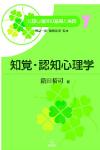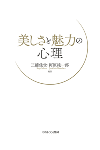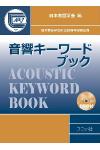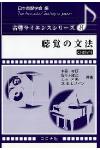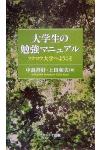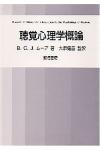 |
局部時間反転音声
音声を録音して,逆再生すると,ちんぷんかんぷんになります。
逆再生音声の例 クリックすると再生できます。原音声: 原音声を再生。
しかし,音声を短い区間に区切り,それぞれを逆再生する,つまり局部的に時間を反転させると聴き取れるようになります。これが局部時間反転音声です(区間長が長いとやはり聴き取れません)。
反転区間長を 170 ms とした例:ここをクリック, 70 ms とした例:ここをクリック, 20 ms とした例:ここをクリック。
このようなことが起こるのは,我々の脳が常に「もっともらしい答え」を探しながら音声を聴いているためです。
原音声は NTT-AT 多言語音声データベース 2002 の一部を使用しています。
関連する業績
- Ueda, K., and Matsuo, I. (2021). Intelligibility of chimeric locally time-reversed speech: Relative contribution of four frequency bands. JASA Express Letters 1(6), 065201, doi: 10.1121/10.0005439
- Ueda, K., and Ciocca, V. (2021). Perceptual restoration of interrupted locally time-reversed speech: Effects of segment duration and noise levels. Attention, Perception, & Psychophysics, 1-7, doi: 10.3758/s13414-021-02292-3
- Matsuo, I., Ueda, K., and Nakajima, Y. (2020). Intelligibility of chimeric locally time-reversed speech, The Journal of the Acoustical Society of America Express Letters, 147, EL523-EL528. https://doi.org/10.1121/10.0001414
- Kazuo Ueda, Yoshitaka Nakajima, Wolfgang Ellermeier, and Florian Kattner. (2017). Intelligibility of locally time-reversed speech: A multilingual comparison, Scientific Reports, 7: 1782, doi:10.1038/s41598-017-01831-z.
雑音駆動音声
自然な音声には,比較的ゆっくりとした声帯音源のパワー変化および声道の動き(振幅包絡)の情報と,声帯の振動による速い動き(時間微細構造)の情報の両方が含まれています。雑音駆動音声は音源を雑音に置き換え,いくつかの周波数帯域の振幅包絡だけを保存した合成音声です。雑音駆動音声では,4 帯域以上の振幅包絡情報があれば,音声を知覚することができます。
4 帯域雑音駆動音声の例:ここをクリック; 20 帯域の例:ここをクリック; 原音声: ここをクリック.
原音声は NTT-AT 多言語音声データベース 2002 の一部を使用しています。
関連する業績
- Ueda, K., Araki, T., and Nakajima, Y. (2018). Frequency specificity of amplitude envelope patterns in noise-vocoded speech, Hearing Research, 367, 169-181 https://doi.org/10.1016/j.heares.2018.06.005.
- Nakajima, Y., Matsuda, M., Ueda, K., and Remijn, G. B. (2018). Temporal resolution needed for auditory communication: Measurement with mosaic speech, Frontiers in Human Neuroscience, 12(149). doi:10.3389/fnhum.2018.00149
- Takuya Kishida, Yoshitaka Nakajima, Kazuo Ueda, and Gerard B. Remijn. (2016). Three factors are critical in order to synthesize intelligible noise-vocoded Japanese speech, Frontiers in Psychology, 7, 517; doi: 10.3389/fpsyg.2016.00517.
- Wolfgang Ellermeier, Florian Kattner, Kazuo Ueda, Kana Doumoto, and Yoshitaka Nakajima. (2015). “Memory disruption by irrelevant noise-vocoded speech: Effects of native language and the number of frequency bands,” the Journal of the Acoustical Society of America, 138, 1561–1569 [http://dx.doi.org/10.1121/1.4928954].
多言語音声の多変量解析
自然な音声に含まれている比較的ゆっくりとした声道の動き(振幅包絡)の情報に注目し,音声が聴覚末梢系で周波数分析された後の音声のパワー変動を変量とした多変量解析(因子分析)を行うことができます。このような分析から,多言語に共通する 3 因子と 4 周波数帯域を導き出しました。
関連する業績
- Ueda, K., and Matsuo, I. (2021). Intelligibility of chimeric locally time-reversed speech: Relative contribution of four frequency bands. JASA Express Letters 1(6), 065201, doi: 10.1121/10.0005439
- Matsuo, I., Ueda, K., and Nakajima, Y. (2020). Intelligibility of chimeric locally time-reversed speech, The Journal of the Acoustical Society of America Express Letters, 147, EL523-EL528. https://doi.org/10.1121/10.0001414
- Ueda, K., Araki, T., and Nakajima, Y. (2018). Frequency specificity of amplitude envelope patterns in noise-vocoded speech, Hearing Research, 367, 169-181 https://doi.org/10.1016/j.heares.2018.06.005.
- Yoshitaka Nakajima, Kazuo Ueda, Shota Fujimaru, Hirotoshi Motomura, and Yuki Ohsaka. (2017). English phonology and an acoustic language universal, Scientific Reports, 7, 46049; doi: 10.1038/srep46049.
- Kazuo Ueda and Yoshitaka Nakajima. (2017). An acoustic key to eight languages/dialects: Factor analyses of critical-band-filtered speech, Scientific Reports, 7, 42468; doi: 10.1038/srep42468.
- Takuya Kishida, Yoshitaka Nakajima, Kazuo Ueda, and Gerard B. Remijn. (2016). “Three factors are critical in order to synthesize intelligible noise-vocoded Japanese speech,” Frontiers in Psychology, 7, 517; doi: 10.3389/fpsyg.2016.00517.
- Wolfgang Ellermeier, Florian Kattner, Kazuo Ueda, Kana Doumoto, and Yoshitaka Nakajima. (2015). “Memory disruption by irrelevant noise-vocoded speech: Effects of native language and the number of frequency bands,” the Journal of the Acoustical Society of America, 138, 1561–1569 [http://dx.doi.org/10.1121/1.4928954].
- Yuko Yamashita, Yoshitaka Nakajima, Kazuo Ueda, Yohko Shimada, David Hirsh, Takeharu Seno, and Benjamin Alexander Smith. (2013). Acoustic analyses of speech sounds and rhythms in Japanese- and English-learning infants. Frontiers in Psychology 4, 1–10 [https://doi.org/10.3389/fpsyg.2013.00057].
無関連音効果
視覚呈示された系列再生課題(たとえばランダムな数字の列を記憶し,再生する)を行うときに,課題とは無関係な音(特に音声)を呈示すると,「音は無視するように」教示されていても,大幅に成績が低下する現象が見られます。この効果が無関連音効果と呼ばれるものです。なぜ,音声がこのような顕著な妨害効果をもたらすのかを調べています。
関連する業績
- Ueda, K., Nakajima, Y., Kattner, F., and Ellermeier, W. (2019). Irrelevant speech effects with locally time-reversed speech: Native vs. non-native language, the Journal of the Acoustical Soceity of America, 145, 3686-3694 [https://doi.org/10.1121/1.5112774]. [PDF]
- Ellermeier, W., Kattner, F., Ueda, K., Doumoto, K., and Nakajima, Y.. (2015). “Memory disruption by irrelevant noise-vocoded speech: Effects of native language and the number of frequency bands,” the Journal of the Acoustical Society of America, 138, 1561–1569 [http://dx.doi.org/10.1121/1.4928954].
有用な情報
- Ellermeier, W. and Zimmer, K. (2014). "The psychoacoustics of the irrelevant sound effect," Acoustical Science and Technology, 35, 10-16 [https://www.jstage.jst.go.jp/article/ast/35/1/35_E141002/_article].【邦訳】ヴォルフガング・エレマイアー,カリン・ツィマー 著,上田和夫 訳. (2013). "無関連音効果の音響心理学," 日本音響学会誌, 69, 638-648.
- 日本音響学会 編. (2016). 音響キーワードブック, "無関連音効果," 上田和夫, 410-411(東京:コロナ社).
|
 |


